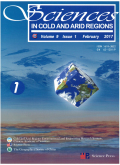- 钛学术文献服务平台 \
- 学术期刊 \
- 基础科学期刊 \
- 天文学、地球科学期刊 \
- 寒旱区科学(英文版)期刊 \
Spatial distribution of supraglacial debris thickness on glaciers of the China-Pakistan Economic Corridor and surroundings
Spatial distribution of supraglacial debris thickness on glaciers of the China-Pakistan Economic Corridor and surroundings
基本信息来源于合作网站,原文需代理用户跳转至来源网站获取
摘要:
Debris-covered glaciers, characterized by the presence of supraglacial debris mantles in their ablation zones, are wide-spread in the China-Pakistan Economic Corridor (CPEC) and surroundings. For these glaciers, thin debris layers acceler-ate the melting of underlying ice compared to that of bare ice, while thick debris layers retard ice melting, called debris-cover effect. Knowledge about the thickness and thermal properties of debris cover on CPEC glaciers is still unclear, mak-ing it difficult to assess the regional debris-cover effect. In this study, thermal resistance of the debris layer estimated from remotely sensed data reveals that about 54.0%of CPEC glaciers are debris-covered glaciers, on which the total debris-cov-ered area is about 5,072 km2, accounting for 14.0%of the total glacier area of the study region. We find that marked differ-ence in the extent and thickness of debris cover is apparent from region to region, as well as the debris-cover effect. 53.3%of the total debris-covered area of the study region is concentrated in Karakoram, followed by Pamir with 30.2%of the to-tal debris-covered area. As revealed by the thermal resistance, the debris thickness is thick in Hindu Kush on average, with the mean thermal resistance of 7.0×10-2 ((m2?K)/W), followed by Karakoram, while the thickness in western Himalaya is thin with the mean value of 2.0×10-2 ((m2?K)/W). Our findings provide a basis for better assessments of changes in debris-covered glaciers and their associated hydrological impacts in the CPEC and surroundings.

推荐文章
Low carbon storage of woody debris in a karst forest in southwestern China
Secondary forest
Fine woody debris
Coarse woody debris
Dead wood
Karst
Subtropical China
Spatial characters of nutrients in Wujiangdu Reservoir in karst river, SW China
Wujiangdu Reservoir
Nutrients distribution characteristics
Dam
Spatial analysis of carbon storage density of mid-subtropical forests using geostatistics: a case st
Carbon storage density
Geostatistics
Mid-subtropical forests
Spatial autocorrelation
Spatial heterogeneity
内容分析
关键词云
关键词热度
相关文献总数
(/次)
(/年)
文献信息
| 篇名 | Spatial distribution of supraglacial debris thickness on glaciers of the China-Pakistan Economic Corridor and surroundings | ||
| 来源期刊 | 寒旱区科学(英文版) | 学科 | |
| 关键词 | |||
| 年,卷(期) | 2020,(6) | 所属期刊栏目 | Articles |
| 研究方向 | 页码范围 | 447-460 | |
| 页数 | 14页 | 分类号 | |
| 字数 | 语种 | 英文 | |
| DOI | |||
五维指标
引文网络
引文网络
二级参考文献 (143)
共引文献 (9)
参考文献 (40)
节点文献
引证文献 (0)
同被引文献 (0)
二级引证文献 (0)
1959(2)
- 参考文献(0)
- 二级参考文献(2)
1969(1)
- 参考文献(0)
- 二级参考文献(1)
1970(1)
- 参考文献(0)
- 二级参考文献(1)
1972(1)
- 参考文献(0)
- 二级参考文献(1)
1981(2)
- 参考文献(0)
- 二级参考文献(2)
1982(1)
- 参考文献(0)
- 二级参考文献(1)
1985(1)
- 参考文献(0)
- 二级参考文献(1)
1987(2)
- 参考文献(0)
- 二级参考文献(2)
1989(1)
- 参考文献(0)
- 二级参考文献(1)
1991(1)
- 参考文献(0)
- 二级参考文献(1)
1993(1)
- 参考文献(0)
- 二级参考文献(1)
1995(2)
- 参考文献(0)
- 二级参考文献(2)
1996(6)
- 参考文献(0)
- 二级参考文献(6)
1997(1)
- 参考文献(0)
- 二级参考文献(1)
1998(4)
- 参考文献(0)
- 二级参考文献(4)
1999(3)
- 参考文献(0)
- 二级参考文献(3)
2000(4)
- 参考文献(0)
- 二级参考文献(4)
2001(3)
- 参考文献(0)
- 二级参考文献(3)
2002(3)
- 参考文献(0)
- 二级参考文献(3)
2003(1)
- 参考文献(0)
- 二级参考文献(1)
2004(6)
- 参考文献(0)
- 二级参考文献(6)
2005(4)
- 参考文献(0)
- 二级参考文献(4)
2006(10)
- 参考文献(0)
- 二级参考文献(10)
2007(8)
- 参考文献(0)
- 二级参考文献(8)
2008(15)
- 参考文献(0)
- 二级参考文献(15)
2009(5)
- 参考文献(0)
- 二级参考文献(5)
2010(9)
- 参考文献(3)
- 二级参考文献(6)
2011(13)
- 参考文献(6)
- 二级参考文献(7)
2012(26)
- 参考文献(8)
- 二级参考文献(18)
2013(10)
- 参考文献(2)
- 二级参考文献(8)
2014(12)
- 参考文献(3)
- 二级参考文献(9)
2015(8)
- 参考文献(5)
- 二级参考文献(3)
2016(4)
- 参考文献(1)
- 二级参考文献(3)
2017(7)
- 参考文献(7)
- 二级参考文献(0)
2018(2)
- 参考文献(2)
- 二级参考文献(0)
2019(1)
- 参考文献(1)
- 二级参考文献(0)
2020(2)
- 参考文献(2)
- 二级参考文献(0)
2020(2)
- 参考文献(2)
- 二级参考文献(0)
- 引证文献(0)
- 二级引证文献(0)
引文网络交叉学科
相关学者/机构
期刊影响力
寒旱区科学(英文版)
主办单位:
中国科学院寒区旱区环境与工程研究所
科学出版社有限责任公司
出版周期:
双月刊
ISSN:
1674-3822
CN:
62-1201/P
开本:
出版地:
甘肃省兰州市东岗西路320号
邮发代号:
创刊时间:
语种:
eng
出版文献量(篇)
870
总下载数(次)
0
总被引数(次)
1072
期刊文献
相关文献
推荐文献
- 期刊分类
- 期刊(年)
- 期刊(期)
- 期刊推荐
力学
化学
地球物理学
地质学
基础科学综合
大学学报
天文学
天文学、地球科学
数学
气象学
海洋学
物理学
生物学
生物科学
自然地理学和测绘学
自然科学总论
自然科学理论与方法
资源科学
非线性科学与系统科学
寒旱区科学(英文版)2022
寒旱区科学(英文版)2021
寒旱区科学(英文版)2020
寒旱区科学(英文版)2019
寒旱区科学(英文版)2018
寒旱区科学(英文版)2017
寒旱区科学(英文版)2016
寒旱区科学(英文版)2015
寒旱区科学(英文版)2014
寒旱区科学(英文版)2013
寒旱区科学(英文版)2012
寒旱区科学(英文版)2011
寒旱区科学(英文版)2010
寒旱区科学(英文版)2009
寒旱区科学(英文版)2008
寒旱区科学(英文版)2020年第6期
寒旱区科学(英文版)2020年第5期
寒旱区科学(英文版)2020年第4期
寒旱区科学(英文版)2020年第3期
寒旱区科学(英文版)2020年第2期
寒旱区科学(英文版)2020年第1期

 免费查重
免费查重










